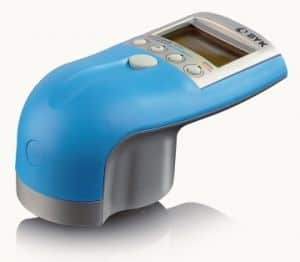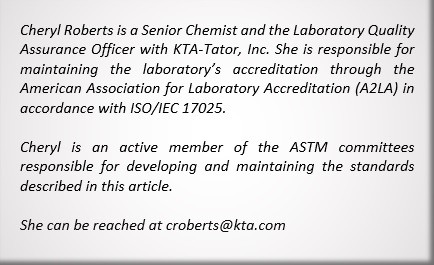Background
 Color is used in the coatings industry for safety (e.g., safety yellow), identification (e.g., pipes coated blue indicate gas flowing through them) and for branding (e.g., company color schemes). The color of a protective coating changes over time; these changes may be caused by aging of the coating and/or exposure to solar radiation (ultraviolet light) from the sun. Darker colors are more prone to color shift than lighter colors. Finish coats designed for exterior use are typically formulated with light stabilizers so that the color shift is minimized. Polyurethane, polysiloxane, and fluorourethane resin systems tend to retain their color longer than vinyl, alkyd, acrylic latex, epoxy and other resin types, but are also significantly more costly. Qualitative changes in color can be detected by the human eye once they become obvious, but minor shifts in color, and/or the need to quantify the change in color can only be determined using color meters. This brief introduction to color measurement describes the technology behind measuring color differences in the coatings industry.
Color is used in the coatings industry for safety (e.g., safety yellow), identification (e.g., pipes coated blue indicate gas flowing through them) and for branding (e.g., company color schemes). The color of a protective coating changes over time; these changes may be caused by aging of the coating and/or exposure to solar radiation (ultraviolet light) from the sun. Darker colors are more prone to color shift than lighter colors. Finish coats designed for exterior use are typically formulated with light stabilizers so that the color shift is minimized. Polyurethane, polysiloxane, and fluorourethane resin systems tend to retain their color longer than vinyl, alkyd, acrylic latex, epoxy and other resin types, but are also significantly more costly. Qualitative changes in color can be detected by the human eye once they become obvious, but minor shifts in color, and/or the need to quantify the change in color can only be determined using color meters. This brief introduction to color measurement describes the technology behind measuring color differences in the coatings industry.
There are several ASTM standard methods for measurement of color. These include ASTM E1349 Standard Test Method for Reflectance Factor and Color by Spectrophotometry Using Bidirectional (45°:0° or 0°:45°) Geometry, ASTM E1331 Standard Test Method for Reflectance Factor and Color by Spectrophotometry Using Hemispherical Geometry, ASTM D2244 Standard Practice for Calculation of Color Tolerances and Color Differences from Instrumentally Measured Color Coordinates, and ASTM E1164 Standard Practice for Calculation of Color Tolerances and Color Differences from Instrumentally Measured Color Coordinates.
Geometry of the Color Measurement – 45/0 or sphere?
 There are basically two types of color meters: 45/0 geometry and sphere geometry. An old joke among color experts is, if you can buy only 2 meters, which two should you buy? A color expert would reply sphere and … gloss. Gotcha! You were expecting sphere and 45/0, right? Color measurements obtained using spherical geometry with the specular component included or “spin” (as opposed to the specular component excluded or “spec”) do not depend on gloss or texture; whereas color measurements taken using bidirectional geometry (45/0) do. If you measure the color of two parts, one smooth and one textured, but otherwise the same—made of the same material and coated with the same paint—the spherical color measurements of the two parts will be roughly the same, whereas 45/0 color measurements will indicate the textured part is lighter. Spherical geometry with spin is recommended for weathering tests and color matching. Bidirectional geometry provides more of an appearance measurement than a pure color measurement and may be used for quality control of a manufactured part.
There are basically two types of color meters: 45/0 geometry and sphere geometry. An old joke among color experts is, if you can buy only 2 meters, which two should you buy? A color expert would reply sphere and … gloss. Gotcha! You were expecting sphere and 45/0, right? Color measurements obtained using spherical geometry with the specular component included or “spin” (as opposed to the specular component excluded or “spec”) do not depend on gloss or texture; whereas color measurements taken using bidirectional geometry (45/0) do. If you measure the color of two parts, one smooth and one textured, but otherwise the same—made of the same material and coated with the same paint—the spherical color measurements of the two parts will be roughly the same, whereas 45/0 color measurements will indicate the textured part is lighter. Spherical geometry with spin is recommended for weathering tests and color matching. Bidirectional geometry provides more of an appearance measurement than a pure color measurement and may be used for quality control of a manufactured part.
Color difference units – ΔE*ab, ΔECMC, ΔE00, or ΔEH?
Although ΔE*ab has been popular in the coatings industry, of the color difference units listed above, ΔECMC best represents color differences as humans see them and therefore is recommended. The (l:c) or lightness-to-chroma ratio must be specified when calculating the color difference in ΔECMC units. The most common values are (2:1), which indicates that lightness differences carry half the importance of chroma and hue differences. ΔEH is frequently used in the coil coatings industry.
Color space – CIE 1976 L* a* b* or Hunter LH, aH, bH?
To determine color difference in ΔE*ab, ΔECMC, or ΔE00, units, the color of the two specimens is measured using L*a*b*. To determine color difference in ΔEH units, the color of the two specimens is measured using LH, aH, bH.
Illuminant – D65 (daylight), A (incandescent light), or F2 or F11 (fluorescent lights)?
The choice of illuminant is dependent on use conditions. This can be difficult to predict as the coated component may be used in a variety of locations that include one or more illuminant conditions. Color appears differently under each of these lighting conditions.
Observer –10° or 2°?
The 1964 CIE 10° Standard Observer is preferred over the 1931 CIE 2° Standard Observer because it correlates better with human color vision.
Considering only the choices described herein: 2 geometries, 4 color difference units, 4 illuminants, and 2 observers generates no less than 64 ways to specify measurement of color difference!
The choice of color measurement parameters may be predetermined, because only measurements taken under the same conditions can be compared. When determining color difference, be sure the color measurements were obtained using the same parameters. For example, if you would like to determine how much the color of a component or structure has faded due to exposure and the pre-exposure measurements were obtained using 45/0 geometry, D65 illuminant, and 2° observer, you should obtain the post-exposure measurements using the same parameters. Also, when comparing differences in color, be careful to only compare differences of the same units; for example, only compare color differences in ΔE*ab units to those in ΔE*ab units and not to those in ΔECMC units.



